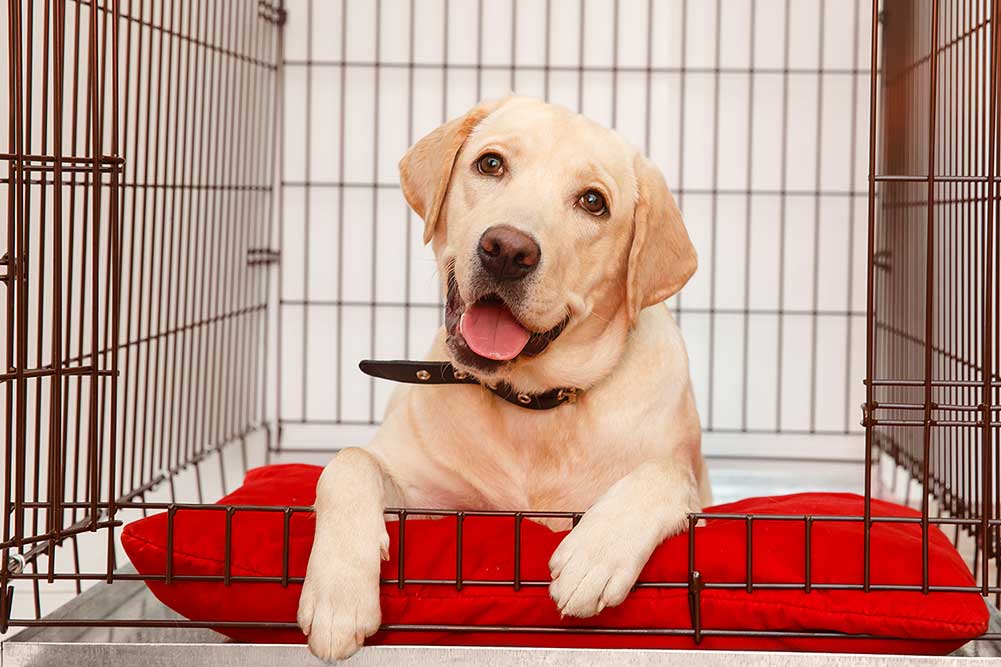
How to crate train an older dog
When it comes to crate training, old dogs can definitely learn new tricks. Crate training (aka kennel training) is important if your dog needs to be confined during an emergency, when you're traveling or just to help her stay calmer during a stressful moment like fireworks. No matter your dog's age, crate training is worth the effort. But if you want to learn the fine art of how to crate train an older dog, the first step is understanding how your pup's needs differ because of her age.

Your Older Pup May Need More Time to Learn
When learning how to kennel train an older dog, keep in mind the process might take quite a bit longer than with a puppy. Puppies are little sponges that learn fast. Older dogs are more set in their ways, so developing new habits takes time.
You May Need to Overcome Negative Past Associations
Your dog might have negative associations with crates from his past that you'll have to work through together. Be extra generous with building positive reinforcement, like giving treats and praise during training.
This also means keeping the crate near you, maybe even in your bedroom initially. Some older dogs are more anxious and might feel isolated and uneasy if they're in a crate where they can't see you.
Make Sure the Crate Is Big and Comfy Enough for Your Older Dog
Older dogs may need crates that are a little more posh than puppies need. Because they can have achy joints or stiffer muscles, getting an extra-roomy crate is a good idea so they don't feel cramped. Of course, don't get a crate that's so big your dog will think he has space to use the bathroom in it!
A great way to make an older dog's crate extra cozy is with a good crate mat. A warming kennel pad like the K&H Self-Warming Crate Pad can be especially soothing for an older dog's achy bones. The self-warming pad warms without needing to be plugged in, making it extra convenient to use.
Another option is the K&H Deluxe Bolster Crate Pad, which includes sizes that fit bigger crates. The raised sides of the crate bed fill the corners, creating extra comfort.
A third comforting choice is the K&H Memory Foam Crate Pad, which comes in a design that fits multiple-sized enclosures and cushions sore joints, yet is thin enough to provide sure footing for your older dog when he needs to stand.
Step-by-Step Tips for Crate Training Older Dogs
Now that you know the modifications you need for your older dog, it's time to begin crate training. Below are the basic steps of the process.
1. Use Treats to Build Positive Associations
Start by helping your pup get comfortable with her new crate. Leave the door open, put a favorite blanket or toy with a familiar smell inside and try tossing in some of her most-loved treats. Once your pup goes inside for treats consistently, start serving her meals in there too. These happy moments can make the crate a more welcoming experience.
2. Close the Door for Short Periods
Once your dog is comfortable eating in her crate, keep the door closed and locked for short periods — just a few seconds to start — and gradually extend the time as your dog becomes more comfortable. Put treats in the crate while the door is closed to build more positive associations.
Eventually, start leaving your home for short periods — just 10 minutes at first, and then up to a few hours. If you're able, record how your dog acts while you're gone. You might be moving too fast if your dog whines or barks a lot while you're out.
3. Leave Your Dog in Her Crate Overnight
Once your dog is comfortable in her crate, you can try leaving her in it overnight. If she cries or whines just a little and then settles down, it's a natural part of the process, and she'll likely be OK to stay in the crate.
It's not recommended to let her out if she just whines a little since this might teach her bad habits. Of course, if she's distressed, you might need to let her out. Signs of distress can include excessive barking, soiling the crate when she's housebroken, drooling, pacing, puking or destructively chewing and scratching at the door. If this happens, you might want to backtrack a bit in your training steps.
4. Teach Her Verbal Commands for Her Crate
Once your dog is comfortable staying in her crate, you can move on to teaching her to go into her crate after hearing a verbal command from you. A good approach is following the same steps suggested for teaching the "place" command.
Older Dogs Can Learn New Tricks, Including Crate Training
Many older dogs can learn to be comfortable in a crate, but it takes time and patience on your part. Just remember: if your pup is resistant or needs a little extra help, there's no shame in asking your veterinarian or a dog trainer for some personalized advice. In the long run, you and your pup will be glad you took the time to train together.



